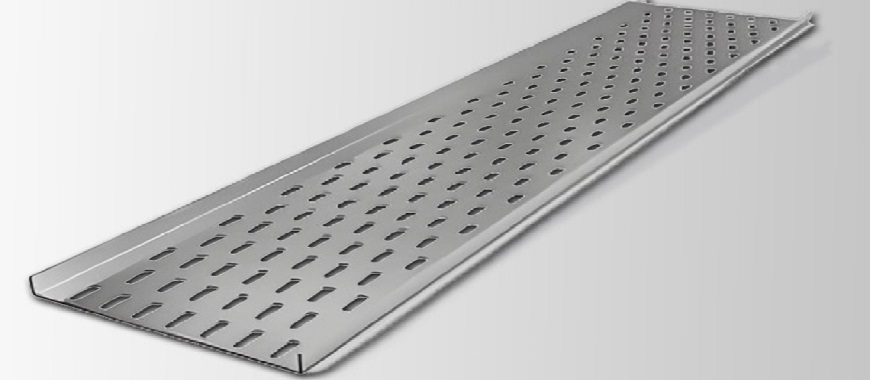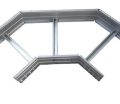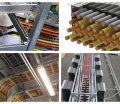
Duct back and cable tray are two widely used solutions for efficient cable management. Both systems offer unique advantages and are suited for different environments. Choosing the right option depends on the specific needs of an electrical application. Proper cable organization ensures safety, reliability, and ease of maintenance in various settings. The comparison of duct back vs cable tray highlights differences in design, functionality, and practical use cases. Duct back provides enclosed protection for cables, while cable trays are ideal for open, visible layouts. Understanding these distinctions is essential for making informed decisions in industrial, commercial, and residential projects. This article explores the key aspects to help identify the most suitable system for your requirements.
Duct Back vs Cable Tray
What is a Cable Tray?
Definition and Common Uses
Cable trays are open-support structures designed to organize and manage cables efficiently in various settings. They are commonly used in industrial, commercial, and large-scale electrical installations where a high volume of cables needs systematic routing. Unlike enclosed systems such as duct backs, cable trays offer visibility and accessibility, making it easier to perform maintenance and inspections.
The comparison of duct back vs cable tray highlights distinct advantages for each system. While duct backs provide maximum protection in hazardous environments due to their enclosed design, cable trays excel in environments where flexibility, accessibility, and efficient heat dissipation are essential.
Cable trays support electrical, communication, and even fiber optic cables, ensuring safe and organized layouts. On the other hand, duct backs are better suited for underground wiring or high-moisture areas where external protection is a priority. By providing adequate support and protection from mechanical stress, cable trays are crucial in environments where neatness and functionality are priorities. In the debate of duct back vs cable tray, the decision often depends on factors like environmental conditions, protection requirements, and ease of maintenance.
Common Applications:
- Industrial Plants: Heavy-duty cable trays route high-voltage cables safely.
- Data Centers: Cable trays provide efficient layouts for IT infrastructure wiring.
- Commercial Buildings: These are used for routing power and communication cables in offices.
- Production Facilities: Flexible designs help accommodate frequently changing wiring needs.
- Utility Infrastructure: Cable trays organize wiring for power grids and substations.
Types of Cable Trays
Cable trays are available in multiple designs to meet the diverse needs of projects. Each type offers unique benefits that make it suitable for specific applications.
- Ventilated Cable Trays: These trays allow air circulation to prevent overheating, making them ideal for high-power applications.
- Ladder Cable Trays: Widely used in industrial setups, they offer robust support for heavy cables.
- Channel Cable Trays: Compact and enclosed, they provide extra protection in confined spaces.
Benefits of Cable Tray Types:
- Ventilated Trays: Minimize cable overheating, promoting efficient operation.
- Ladder Trays: Provide excellent strength and support for heavy-duty cables.
- Channel Trays: Enhance cable protection in environments requiring enclosed systems.
Common Cable Types in Trays
Cable trays are compatible with various cable types, depending on the application. The National Electrical Code (NEC) defines specific guidelines for cable tray usage, ensuring compliance and safety.
- Tray Cables (TC): Commonly used in industrial settings for power distribution.
- Fiber Optic Cables: Used in communication systems for high-speed data transmission.
- Communication Cables: Suitable for networking and telephone systems.
- Fire Alarm Cables: Designed for emergency systems requiring high reliability.
- Conduit-Compatible Cables: Certain tray cables are used in hybrid setups where trays connect to conduits.
What is a Duct Back?
Definition and Function
Duct back systems are enclosed pathways used to protect and organize wiring in critical applications. They are typically constructed from durable materials like metal or plastic to shield cables from physical and environmental damage. Unlike cable trays, duct backs provide a fully enclosed structure, ensuring wires remain protected from external hazards such as dust, moisture, and mechanical impact. These systems are often utilized in settings requiring higher protection standards, including HVAC systems and underground installations.
Materials Commonly Used:
- Metal: Provides high durability and grounding capabilities.
- Plastic: Lightweight and resistant to corrosion.
- Composite Materials: Offer enhanced flexibility and strength.
Applications of Duct Back Systems
Duct back systems are versatile and serve a variety of specialized environments. Their enclosed design makes them ideal for areas where cables require extra protection.
Use Cases:
- Industrial Settings: Protect power and control cables in high-risk areas.
- HVAC Systems: Route electrical wiring alongside ventilation ducts.
- Underground Wiring: Shield cables from moisture and soil pressure.
- Hazardous Locations: Prevent damage from chemicals or extreme temperatures.
- Residential Use: Ensure safe cable management in homes with concealed wiring needs.
Reliable Cable Tray Sleeve Options for Industrial Applications
Duct Back vs Cable Tray: Key Differences
| Feature | Duct Back | Cable Tray |
|---|---|---|
| Cost | Higher initial cost due to materials. | More cost-effective, especially for large setups. |
| Installation | Requires precise installation for proper sealing. | Easier and faster installation process. |
| Visibility | Enclosed design conceals cables completely. | Open design allows for visibility. |
| Maintenance | Maintenance is more complex. | Maintenance and inspection are easier. |
| Environmental Suitability | Ideal for harsh or hazardous environments. | Best suited for dry and accessible areas. |
Understanding the differences between duct back vs cable tray is essential for making informed decisions in cable management. Each system offers unique advantages and is suited for specific environments. Cable trays are ideal for cost-effective, flexible setups with easy maintenance, while duct backs provide enhanced protection in hazardous or concealed environments. By assessing factors such as cost, installation, visibility, and environmental conditions, project designers can choose the most suitable option for their needs. Both systems play critical roles in ensuring efficient, reliable, and safe cable management in modern infrastructure.
Comprehensive Guide to Cable Tray and Support Systems
Use Cases for Duct Back vs Cable Tray
When to Choose a Cable Tray
When considering duct back vs cable tray, cable trays emerge as the preferred choice for environments where high visibility, accessibility, and flexibility are essential. Their open design allows for quick inspection, easy adjustments, and efficient maintenance, making them a robust solution for managing cables in diverse applications.
Cable trays are especially ideal for projects requiring frequent modifications or where heat dissipation is critical. For example, data centers and industrial plants benefit from the open structure, which prevents cable overheating and ensures smooth operations. Unlike duct backs, which offer enclosed protection, cable trays provide easier access to cables, simplifying troubleshooting and repairs.
When selecting between duct back vs cable tray, consider the specific needs of the project. If flexibility, scalability, and accessibility are top priorities, a cable tray system is likely the better option. However, in hazardous or moisture-prone environments, the enclosed design of duct backs might offer the necessary protection. By assessing these factors, project planners can ensure the right system is chosen for optimal performance and long-term reliability.
Key Environments for Cable Tray Use:
- Data Centers:
Cable trays excel in organizing the complex wiring of data centers. Their open design allows technicians to quickly identify and resolve issues without dismantling the system. The ability to handle high-density cabling ensures optimal airflow and prevents overheating, which is critical in IT infrastructure. - Factories and Production Facilities:
In industrial setups, cable trays provide excellent strength and durability for heavy-duty cables. Their flexibility supports frequent modifications, which is essential in environments with evolving machinery layouts. - Commercial Buildings:
Office spaces often use cable trays to route power, networking, and communication cables. Their open structure ensures that maintenance teams can perform quick inspections and make adjustments with minimal disruption. - Large-Scale Electrical Installations:
Projects involving high-capacity electrical systems benefit from the cost-efficiency and scalability of cable trays. Their modular design makes it easy to expand or reconfigure as needed. - Utility and Power Plants:
Cable trays support heavy loads in utility installations, ensuring safe and efficient cable management in power plants and substations.
Preferred Applications for Duct Back
Duct back systems are best suited for environments where cables require enhanced protection and containment. Their enclosed design ensures maximum safety and reliability in challenging conditions.
Key Applications for Duct Back Systems:
- HVAC Systems:
Duct backs are commonly used alongside HVAC systems to protect electrical wiring from heat and vibration. The enclosed structure prevents dust accumulation and ensures long-term reliability, even in environments with fluctuating temperatures. - Underground Wiring:
In underground installations, duct backs shield cables from moisture, soil pressure, and physical damage. This makes them an excellent choice for projects requiring durability and protection against harsh environmental conditions. - Hazardous Environments:
Industrial facilities dealing with chemicals, extreme temperatures, or heavy mechanical stress benefit from the robustness of duct back systems. Their ability to fully contain cables reduces the risk of damage and ensures safe operations. - High-Moisture Areas:
Locations like basements or tunnels require wiring solutions that prevent water ingress. Duct back systems excel in such environments by providing a sealed pathway for cables. - Residential Applications:
In homes, duct backs ensure concealed and secure wiring for aesthetic and safety reasons. Their versatility allows integration with other systems for efficient cable management.
Combining Systems for Optimal Design
In many cases, integrating duct back and cable tray systems creates an optimized wiring solution. Combining these systems leverages their respective strengths to meet complex project requirements.
Scenarios Where Integration Works Best:
- Hybrid Industrial Projects:
Facilities that require robust cable protection in some areas and open accessibility in others can benefit from a hybrid approach. For example, duct backs can protect cables in high-risk zones, while cable trays simplify organization in general areas. - Long Cable Routes:
Projects involving extensive cable runs, such as in power plants or large commercial buildings, often combine the two systems. Duct backs can handle underground sections, and cable trays manage above-ground routing for easy access. - Critical Environments:
Data centers or laboratories with sensitive equipment may use cable trays for flexibility and duct backs for added protection in specific zones. This ensures cables remain safe without compromising accessibility where needed. - Transition Points:
When cables move from enclosed spaces to open areas, duct back systems can seamlessly connect to cable trays. This integration ensures a continuous and efficient wiring pathway. - Future-Ready Designs:
Combining duct backs and duct cable trays in the initial setup allows flexibility for future expansions or modifications. It creates a scalable infrastructure capable of adapting to evolving needs while maintaining efficiency and protection.
Practical Tips for Integration:
- Use transition fittings to connect duct backs and cable trays smoothly.
- Plan layouts to minimize sharp bends and optimize cable flow.
- Ensure proper grounding in both systems to maintain safety and compliance.
- Evaluate environmental factors to select the appropriate materials for each section.
- Conduct regular inspections to ensure both systems function cohesively.
Top Materials for High Voltage Cable Tray Applications
Final Thoughts on Duct Back vs Cable Tray
The choice between duct back vs cable tray depends on the specific needs and conditions of each project. Each system has distinct advantages and limitations that make it suitable for particular environments.
Summary of Advantages:
| Feature | Cable Tray Benefits | Duct Back Benefits |
|---|---|---|
| Cost | Cost-effective and scalable for large installations | Higher initial cost but offers long-term savings through protection |
| Design | Open design simplifies inspection and maintenance | Enclosed design offers maximum protection in hazardous conditions |
| Flexibility | Ideal for environments requiring flexibility and accessibility | Best for applications needing sealed cable containment |
| Environmental Suitability | Suitable for dry, accessible environments with frequent maintenance needs | Suitable for underground, high-moisture, and high-risk environments |
| Aesthetic and Safety | Focus on visibility and functionality | Provides aesthetic and safety benefits in residential and commercial applications |
- Cable Tray Benefits:
- Cost-effective and scalable for large installations.
- Open design simplifies inspection and maintenance.
- Ideal for environments requiring flexibility and accessibility.
- Duct Back Benefits:
- Enclosed design offers maximum protection in hazardous conditions.
- Suitable for underground, high-moisture, and high-risk environments.
- Provides aesthetic and safety benefits in residential and commercial applications.
Summary of Limitations:
| Feature | Cable Tray Benefits | Duct Back Benefits |
|---|---|---|
| Cost | Cost-effective and scalable for large installations | Higher initial cost but offers long-term savings through protection |
| Design | Open design simplifies inspection and maintenance | Enclosed design offers maximum protection in hazardous conditions |
| Flexibility | Ideal for environments requiring flexibility and accessibility | Best for applications needing sealed cable containment |
| Environmental Suitability | Suitable for dry, accessible environments with frequent maintenance needs | Suitable for underground, high-moisture, and high-risk environments |
| Aesthetic and Safety | Focus on visibility and functionality | Provides aesthetic and safety benefits in residential and commercial applications |
- Cable Tray Drawbacks:
- Limited protection against environmental hazards.
- Requires regular cleaning to prevent dust accumulation.
- Duct Back Drawbacks:
- Higher initial cost and complex installation process.
- Maintenance can be more challenging due to enclosed design.
Achieving Efficiency and Reliability:
To achieve optimal cable management, it’s essential to assess project-specific needs thoroughly. Factors such as cost, environmental conditions, and maintenance requirements should guide the selection process. In some cases, integrating duct back and cable tray systems may provide the best solution, combining their respective strengths to meet complex demands.
By understanding the key differences and applications of duct back vs cable tray, project planners can ensure safe, efficient, and reliable wiring systems that meet long-term objectives.
FAQs about Duct Back vs Cable Tray
Cable ducts and cable trays serve different purposes in cable management systems. Cable ducts are enclosed pathways designed to protect cables from environmental factors like moisture, dust, and physical damage. They are often made from metal or plastic materials and are best suited for areas requiring complete containment, such as underground or hazardous environments.
In contrast, cable trays are open-support systems used to organize and route cables in industrial and commercial settings. They provide visibility, easy maintenance, and flexibility, making them ideal for high-density cabling or environments where regular modifications are required. Unlike cable ducts, cable trays offer minimal protection against external elements but excel in heat dissipation and accessibility. The choice between a cable duct and a cable tray depends on the specific needs of the application, such as the level of protection, accessibility, and environment.
The three main types of cable trays are ladder trays, ventilated trays, and channel trays. Each type serves distinct purposes and is designed for specific applications.
Ladder trays are the most common and are used in industrial settings to support heavy-duty cables. Their rungs provide excellent strength and allow for efficient heat dissipation, making them ideal for high-power installations. Ventilated trays, on the other hand, feature a perforated base that offers partial enclosure while promoting airflow. They are often used for medium-duty applications where cable protection and heat management are necessary.
Channel trays are compact and fully enclosed, offering better protection for cables in confined spaces or areas where mechanical damage is a concern. These are typically used in commercial buildings or spaces requiring concealed wiring. Choosing the right type of cable tray depends on the load requirements, environmental conditions, and type of cables being installed.
Cable trays and cable trunks differ in structure, application, and functionality. A cable tray is an open structure designed to support, organize, and route cables in industrial or commercial settings. It allows easy access for installation, inspection, and maintenance. Its open design facilitates heat dissipation, making it suitable for high-capacity wiring systems.
Cable trunks, in contrast, are enclosed pathways that provide complete protection for cables. They are often used for aesthetic purposes in residential or commercial spaces where cables need to be concealed. Unlike cable trays, cable trunks are more rigid and provide better mechanical protection but are less flexible in terms of modifications. The choice between a cable tray and a cable trunk depends on the project’s specific needs, including accessibility, protection, and aesthetics.
The difference between a cable tray and a raceway lies in their design and purpose. A cable tray is an open-support system that allows cables to be laid out without full enclosure. It is ideal for environments where frequent maintenance or modifications are required, such as factories or data centers. The open design promotes airflow and heat dissipation, ensuring the cables function efficiently.
A raceway, however, is a fully enclosed system that offers complete protection for cables from environmental hazards and physical damage. Raceways are often used in hazardous or outdoor environments where cables need shielding from moisture, dust, and other elements. While cable trays are more accessible and flexible, raceways provide better protection and containment. The decision to use a cable tray or raceway depends on factors such as environment, level of cable protection, and ease of access needed for maintenance.

As the editor of GangLong Fiberglass, I have years of experience and in-depth research, focusing on cable tray products, fiberglass solutions, and grille systems. I incorporate years of industry insights and practical experience into every content, committed to promoting the progress of the industry. At GangLong Fiberglass, my commitment is reflected in every product, from innovative cable trays to durable fiberglass solutions and sturdy grille systems. As an authoritative voice in the industry, my goal is to provide valuable information to professionals and businesses and promote forward-looking solutions.


